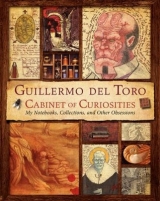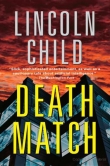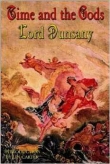
Текст книги "Cabinet of Curiosities: My Notebooks, Collections, and Other Obsessions"
Автор книги: Guillermo del Toro
Соавторы: Marc Scott Zicree
Жанры:
Публицистика
,сообщить о нарушении
Текущая страница: 7 (всего у книги 17 страниц)
NOTEBOOKS

Notebook 3, Pages 4A and 4B.

Sketch of a poster idea del Toro made when trying to find an American distributor for the film.

Angel de la Guardia (Ron Perlman) and Jesús Gris (Federico Luppi) in Gris’s antique shop.

The bottom of one of the original Cronos device props.

A sketch of the aging Dieter de la Guardia by del Toro.

Jesús Gris (Federico Luppi) examines the statue of the angel while his granddaughter, Aurora (Tamara Shanath), looks on.
CRONOS
WATCHING A FILM in a theater holds a unique power. Guillermo del Toro works and has worked in many media, but he prefers movies because in the theater the image is vast, all-encompassing, inescapable—forming the totality of the viewer’s experience in that moment. In a theater, the audience is propelled along a time frame that the director dictates. Unlike at home or in other contexts, viewers can’t pause the story, step away for a few minutes, read a paper, call a friend, and then return at their convenience. Guillermo is a maestro who insists on full attention and immersion, and this is what the movie theater provides. In addition, film allows Guillermo to unite all his artistic proclivities in one singular vision, and so movies became his medium of choice.
Cronos (1993) was Guillermo’s first foray into feature film. For many novice filmmakers, their first film is an embarrassment they want to put behind them. Commenting on Fear and Desire, his first feature, Stanley Kubrick once said that he didn’t want the film to be remembered or shown again because it was a “bumbling, amateur film exercise… a completely inept oddity—boring and pretentious.”
Not so with Guillermo and Cronos. This astonishing film reveals an already-mature visionary. It is a personal, profound philosophical rumination on the choices unconditional love demands when faced with the facets of our nature we cannot control—sexual obsession, hunger, mortality. It forces us to ask where we draw the line on our actions.
A vampire film where the word vampire is never used, Cronos presents a merciless world where mercy survives in the face of uncontrollable appetite but only at a grave cost. The characters face hard choices and are pushed to ever more extreme actions. All of it unfolds in a fantasy realm that blends the Jalisco of Guillermo’s youth with the Grand Guignol world he soaked up from books and films.
In the film, it’s initially easy for Aurora (Tamara Shanath), like any granddaughter, to love her gentle grandfather, Jesús Gris (Federico Luppi), who stays reassuringly the same. But what do you do when your grandfather inexplicably gets younger, more vigorous—and then, astonishingly, returns from the dead, growing ever more horrific looking? In Aurora’s case, you see the soul within and cherish it, regardless of outside appearances. You tuck him into your toy chest with your plush bear; you shield him from the light and witness his final moments of existence. As for Jesús Gris, who is transformed by the exquisite, monstrous Cronos device into a deathless addict, he chooses to destroy both himself and the device rather than sacrifice his granddaughter on the altar of his need.
With these characters, their monstrous circumstances, and their difficult choices, Guillermo confronts his audience with an inescapable truth of life: that those we love, and we ourselves, will ultimately be made horrible by either accident or illness, and certainly by death. Constancy and devotion are possible only by virtue of love, which alone endures.

Jesús Gris (Federico Luppi) succumbs to the device in Cronos.
In his first film, Guillermo announced his singular aesthetic: his desire to utilize classic horror tropes to strip away artifice and show us clear reality—albeit his reality, his world. With Cronos, Guillermo gave voice to the world inside himself.
Guillermo took ten years building the makeup and special effects infrastructure (through his company Necropia) that would allow him to make this film, and its production was fraught with trouble. At one point, financing collapsed during shooting, and Guillermo had to tell star Ron Perlman, whose agent advised him to quit, “I can’t pay you now, but I promise you will get paid.” The time and attention to detail paid off. In Cronos, many of Guillermo’s major themes are on display, particularly child/parent and especially child/grandparent relationships, the fragility of innocence and its inevitable dance with corruption, and the sociopathic impulse that spoils for an excuse to let loose unbridled violence.
While working on Cronos, and as he would do with all his films, Guillermo kept a detailed notebook full of his illustrations, concepts, and thoughts. These are suggested by the storyboards, sketches, and production stills that follow, but none of this artwork is from the notebook itself.
For that, blame James Cameron.
“When I was finishing Cronos, Jim and I went to an Italian restaurant in Santa Monica,” Guillermo explains, “and it was a very, very, very dire time. I was staying in a hotel that was three hundred dollars a month, so it was very, very economical. With that hotel, most of the time the plumbing did not work, so I had to go to another hotel every three days and rent a room just to take a shower—or I could have a hot dog at Pink’s. Those were my choices. The day I took the shower, I couldn’t eat lunch.
“So when I met Jim Cameron, I was really filthy. I was a disaster. And he said, ‘Order what you want.’ And I thought, Oh my God, I’d better carve up for the whole week. I ordered like a madman, and wine kept pouring, and I got completely bloated and drunk. I said to Jim, ‘I want you to have my notebook for Cronos’, which was a Day Runner full of notes. I gave it to him, and Jim received it, and I think he was also not completely sober.
“The end of the story is that the notebook—he says that he placed it somewhere. He still lives in the same house, so I have hopes, but he says that he hasn’t been able to find it since.”
As a result, the pages that follow can only hint at what the Cronos notebook held, at what it still holds, like a snippet from a lost work of Sophocles quoted in a play by Aristophanes or snapshots of the Ark of the Covenant that is itself crated and buried in the closing-credits warehouse in Raiders of the Lost Ark.
What’s clear from the surviving Cronos storyboards and sketches is that, from the beginning, Guillermo possessed a bold creative vision and the ability to communicate it. In the years to come, Guillermo would make bigger films, more ambitious ones, but from the first he staked out a territory that was all his own.

The top of one of the original scarab props.

Sketch of a poster idea del Toro made when looking for an American distributor for the film.
GDT: I did this illustration of the Cronos device tearing into the skin [above] to show a possible idea for a poster for the film’s release. At the time, we were sending the movie out to American distributors, and I wanted to convey the idea that Cronos could be marketed. I was particularly happy with this image and the distributor, October Films, liked it, but they changed it for an image of a woman—like a girl having an orgasmic reaction to the device.
And the storyboards here [right] are rare—very few storyboards for Cronos survived. These particular story-boards were for an original prologue that I discarded, which was to start in the dark and then show the alchemist harvesting the insects.
MSZ: I know storyboarding is something you do on an ongoing basis while you’re working on your films. Can you talk a little bit about how you use them?
GDT: I now just doodle because it serves the same function as a more elaborate drawing. Even if you’re just using shapes, you can still communicate how you want to organize the frame—you’re still able to share the composition. I’ll give my doodle to someone who can interpret it and make it useful for preproduction. For example, if it’s for a VFX shot or a makeup effects shot, they’ll do a better job rendering the scene for budgeting.
I also use storyboards when I’m shooting. I call it the poor man’s Avid. Because I can edit on the page while I’m shooting. If I have sixteen or twenty setups I can put them all out on a sheet of paper and decide if I want to go from this one to that one, or if I have to skip one—you know, as time gets tighter. Storyboards are a great tool for making decisions like that.
MSZ: But this particular storyboard seems much more detailed. Was there a time when you drew more elaborate storyboards?
GDT: This one is so detailed because we were trying to budget for the effects we needed. I wanted to show the insect moving in the foreground, but I didn’t want to show its shape. So the storyboard was important for communicating how much we really needed to reveal to my guys at Necropia.

One of the few surviving storyboards for Cronos, this one for an unfilmed introduction to the film.

Concept by del Toro of the scene where Jesús Gris bites Dieter de La Guardia and drinks his blood.
MSZ: And what is this color piece over here [above]?
GDT: That is a preproduction painting I did to show what I wanted to happen to de la Guardia when Gris bites him and drinks his blood. I wanted it to be all in blue and red, but I didn’t know how to do it with the budget we had.
MSZ: The colors are reminiscent of the contrast of the red and the blue in Hellboy, of Hellboy and Abe Sapien.
GDT: I normally mix a warm color with a cold color. I think red and blue is a color scheme that is a lot more 1990s at this point. But I also like to combine cyan with gold or amber, because there is a lot of gold in cyan. And if you use the right shade of amber, there’s some green in it, so they can be complementary colors.
MSZ: Something I noticed in this artwork—in both the poster and the color pieces—is the signature.
GDT: The signature is my take on Will Eisner’s signature. I’m a big Will Eisner fan, and I tried to combine his name with my name, because you know “Will” and “Guillermo” are the same name. And I used to add that little comic book bubble, too.

Excerpt from the manual that describes how to operate the Cronos device.

These pages, designed by Felipe Ehrenberg, influenced del Toro’s approach to his future notebooks.
GDT: These pages are from the diary in the film, which were drawn by Felipe Ehrenberg, who did a fabulous job. I’ve always been obsessed with the props in my films looking the right way, and this prop was perfect.
MSZ: Each film of yours seems to have a special book.
GDT: I try to put books in all of my movies so I can keep them. This particular one also has patterns I ended up using in my diary.
MSZ: Yes, I wanted to ask about that because the Cronos book prop predates the diaries you acquired in Venice and your new approach to recording your thoughts in the notebooks.
GDT: I love the contrast of the crimson and the sepia, which comes from medieval and Renaissance diaries. I tried to adopt that in the first Hellboy notebook.
MSZ: And what about the storyboards [opposite], which depict the alchemist making notes in the book?
GDT: These are for the sequence in the movie where we show the alchemist in his workshop. Originally, we were going to go to a monastery to shoot the scene. But we didn’t have the money to pay for transportation to go to a separate location. So the final alchemist scene, if you want to call it that, ended up being shot against a backdrop in the same house where we shot the rest of the movie. And all we had was a piece of fabric and a stove. So it was much less elaborate.
MSZ: You’ve spoken, too, about admiring Vermeer and his compositions. There seems to be a strong resonance here, particularly in this first frame of the storyboard.
GDT: I wish! We tried to do this sort of beam of light but we realized that we couldn’t, because you need distance for the light to travel to produce that effect. The light needs to have enough of a “shoot,” and you need to have atmosphere on the set—to put a lot of smoke in the set—to get that “ray of light” effect. I wasn’t able to do it here. I was able to do it when Gris encounters the sunlight upstairs in the attic, though, when all the little holes create pins of light. The lights on that set were very, very high.

Storyboards by del Toro of an unfilmed scene introducing the alchemist who originated the Cronos device.

Concept by del Toro of the final scene where Angel de la Guardia and Jesús Gris face off in front of the massive sign at the top of the de la Guardia family’s building.

Gris (Federico Luppi) and Aurora (Tamara Shanath) walk along the sign in the final film.
GDT: This [above] was done in preproduction, and it was supposed to represent what I wanted for the sign in the finale. I wanted these guys to fight in front of a huge, broken clock, to show that Gris is immortal.
Also, in the drawing, Gris’s hair is black. Originally, the idea was that he would use black shoe polish to paint his hair, and in the end the front of his hair would be all white and the back would be all black, with tears of black streaming down his face. But that would have meant a lot of time in the makeup chair, which we didn’t have.
MSZ: Is there any association between the stopped clock and the gears of the Cronos device?
GDT: Yes, of course. Cronos is about immortality and how we want time to stop. All these characters are seeking immortality or fearing it, but the only immortal character, in a sense, is the granddaughter who simply does not care about it. Therefore she is immortal.
Also, I love gears as an image. In Cronos, they are literally time and mortality—the transition between life and death. But I like that they can mean many things: the universe as a mechanical model; the cycle between good or evil; or between creation and consumption. It’s a huge machine, precise but nonlinear and made of flow and flexibility. But like with anything big, if you zoom back enough, there is order in chaos and chaos in order. Gears symbolize that, amongst other things.
For instance, in Pan’s Labyrinth they signify history. And, at the same time, very literally, the fact that the captain is trapped inside his father’s watch—there are these giant gears behind him in his office. In terms of the story, they come from the mill, so it’s logical, but symbolically, he keeps obsessing about this watch, and time, and being remembered, and being important. So gears mean different things in the movies I’ve made.
RESURRECTION
RON PERLMAN

A sketch of Ron Perlman as Hellboy from Notebook 3, Page 44A.
IT WAS TOWARD THE END of the second year of the biggest malaise of my life—which was both artistic and personal. It was a midlife crisis of dynamic proportions. Whatever creative fire had once driven me had long since been extinguished. I wasn’t even answering the phone. Then, a parcel arrived in the mail. It was a parcel that, for me, would come to have near mystical dimension. Inside was a script and a handwritten letter from an unknown Mexican filmmaker asking me to participate in a little experiment that was to be the first film in his oeuvre—Cronos. Up until then, I had been doing esoteric projects that I thought nobody in the entire universe had even noticed, particularly my minor contributions. Then, all of a sudden, this beautiful handwritten love letter arrived describing in minute detail the most subtle nuances of my work in these little fringe projects. I was stunned.
I began reading the screenplay while working out on an exercise bike at the Hollywood YMCA; a fairly prominent indie filmmaker was reading over my shoulder. Aside from complaining that I was reading too slowly, she commented about how strange this little screenplay seemed. What was it and where did it come from? And I said, “Well, it’s the weirdest little vampire movie I’ve ever seen. But it’s also the smartest. Never in a million years would it ever get greenlit in Hollywood. And just for that reason alone, I’m going to fucking do it.”
Shortly thereafter, Guillermo came to Los Angeles. We had dinner, and by the time we finished, it seemed like we were two guys who had known each other for thirty years. There was just this immediate ease.
The only problem was that Guillermo had sent me the script in beautifully written English, so I never imagined it was going to be filmed in another language. I didn’t know that until I met him at the Mexico City airport. A tiny lightbulb went off, and I said, “Can I ask… what language are you shooting in?” And he said, “Spanish, my friend!” I said, “You do realize I don’t speak Spanish?” And he said, “Let’s go eat!”
I went back to the hotel after a sumptuous meal and said to myself, “I’ll show him! I’m going to give this performance in perfect Spanish.” I began to prepare two of Angel’s longer speeches. I called Guillermo the following morning, not having slept, and arranged to meet him at his production office. I read the first speech. When I finished, he said nothing. So I read the second speech. I thought I was phenomenal! Again he said nothing. So finally I said, “How was that?” And he said, “That was bad, very, very bad. You sound like an idiot.” So I said, “Well, what are we going to do? We start shooting tomorrow!” And he said, “Let’s go eat!”
When filming Cronos, his first big movie, Guillermo was very humble about the responsibility he was charged with. And being somebody who has a true passion and reverence for the medium, he put a lot of pressure on himself. But once he started filming, it seemed like he had been doing it his whole life. The minute I saw the imagery, I knew I was dealing with somebody in the same class as Luis Buñuel and François Truffaut.
Cronos was the first time I experienced truly independent cinema. It was the first time I’d ever worked on a non-studio, non-mainstream movie. Since then, I’ve appeared in over forty low-budget films for first-time directors. There was a magic that took place as I watched Guillermo do his thing in a setting that didn’t involve a big corporate organization. He was surrounded by people who loved him, believed in him, and enabled him—under some very compromising conditions—to make his movie.
I give Guillermo credit for jump-starting the entire second half of my life, which I have continued to try to make about independent cinema. I give him total credit for opening my eyes to what real cinema looks like. The impact Guillermo has had on my life goes far beyond the credits on my resume. That is nothing compared to how profoundly knowing him has changed the course of my life.
MIMIC

Del Toro and assistant director Walter Gasparovic on the set of Mimic.

A concept of one of the giant insects by TyRuben Ellingson.

Sketch of a mimic profile by del Toro.

Keyframe of a chase scene in the sewers by Ellingson.

Judas breed “dead boy” concept by Ellingson.
“AN EVOLUTIONARY LEAP. Evolution’s on their side.” This comment by Guillermo in his Mimic notebook sums up his second film’s key question. In Mimic (1997), New York entomologist Dr. Susan Tyler (Mira Sorvino, fresh off winning her Best Supporting Actress Oscar for Mighty Aphrodite) inadvertently alters cockroaches’ genetic code so that they evolve into six-foot-tall creatures that mimic the appearance of human beings.
For Guillermo, Mimic had an ironically apt title, as it’s ostensibly about a creature trying to imitate something utterly alien to its nature. This was Guillermo’s fledgling attempt to shoot a studio film as a studio director, to assume the role of a commercially minded technician while maintaining his artistic core and instincts. Like many of the bugs in the film, Guillermo got squashed, in this case by the studio machine. Eventually, the film was taken away from him and recut, with sequences added by another director. For Guillermo, it was a soul-crushing experience.
In the end, he learned vital lessons for the future. Afterward, he would consistently favor artistic choices over commercial ones as he built a singular and successful career. “This is a struggle you have as an artist,” Guillermo notes. “Hellboy in Hellboy II, when he shoots the elemental, he’s shooting it because he wants people to like him. He goes, ‘Well, okay, I’m going to do the right thing for these guys to like me because they don’t like me.’ And he comes out and delivers the baby like, ‘I did a great thing,’ and they boo him and they throw stones at him. As an artist, I’ve gone through that. You say, ‘Okay, I’m going to do what people like.’ I go and do a commercial movie like Mimic, and it’s a huge hurt in my life. Then when you go and do the hard choice, there’s a reward in there.”
Thankfully, in 2011, Guillermo released a “director’s cut” of Mimic that gives audiences his version of the film (or as close to it as it’s possible to get now). Filled with unforgettable images and powerful scenes that were not in the theatrical release, Guillermo’s version includes a stunning opening sequence in a church hospital, dreamily white, its long arched hall narrow and high, with rows of patients’ beds—all children—draped in opaque fabric lit from within, like embryonic sacs or insect chrysalises.
“It was the first day of shooting of Mimic, and I thought it was a very beautiful, a very striking image,” Guillermo recalls. “It was the first image that got me into deeper trouble because some of the producers hated that image from the start. They said, ‘It doesn’t look like a real hospital. It looks like something off another planet. What are you doing? Are you making an art film out of a B-movie bug picture?’ And I said to them, ‘Well, I think they are one and the same. I think that the movie needs to be sumptuous, look beautiful, but have a real emotional sense,’ and so on and so forth. It was a losing proposition from the get-go.”
With Mimic’s restoration, one can perceive how incredibly beautiful the film is when considered shot by shot, with its rich golds and blues, its textures of brick and coursing rain. Restored to a lyrical and patient pacing, it’s now unmistakably a Guillermo del Toro film, exhibiting his attention to detail and his tendency for observed, held moments.
Even without these amendments, many of Guillermo’s dominant themes and motifs feature prominently in Mimic, notably his fascination with mechanisms and insects, which are presented almost like living mechanisms. By cloaking his creatures in protective camouflage as faux humans, Guillermo urges us to consider humans as organic mechanisms, too—this visual alignment becoming a paradox that mixes physical sameness with spiritual difference.
“Insects are really well-engineered by nature,” Guillermo observes. “They are awe-inspiring, but I don’t find them admirable in their function, socially or spiritually. And I think that’s why we fear them, because they have a complete lack of emotion. They are the true living automatons of nature. That’s why they work as symbols of so many things…. They’re completely alien.”
The character of the little boy Chuy (Alexander Goodwin) also raises this question of what defines humanness. Due to his autism, Chuy is unlike other people, and at first he quietly observes the giant insects and reacts with curiosity, rather than disquiet or fear. The film itself takes a similarly ambivalent perspective on the creatures, showing them in both understandable and repulsive ways.
As in Cronos, central to the story is the emotionally moving child/grandparent relationship between Chuy and the shoeshine man Manny (Giancarlo Giannini). The other main relationship is between Susan Tyler and her husband, Dr. Peter Mann (Jeremy Northam). While the human couple struggles with issues of fertility, the faux-human insects have no such difficulties or doubts and multiply at a staggering rate.
Interestingly, it was because of Mimic that the public got its first glimpse of Guillermo’s notebooks. Guillermo and Mira Sorvino were on the Charlie Rose show promoting the film. “Mira said, ‘You should show him your notebooks,’“ Guillermo recalls. “And I showed the book for the first time in that interview. I actually made a fool of myself. I think they edited it out, but I was really nervous about Rose putting a thumbprint on it. I’m very anal-retentive about my stuff. I was telling Charlie Rose, ‘Oh, give it back to me.’ And I’m like this stupid guy who had no idea how to behave in media or whatever.

Judas breed “nymph” concept by TyRuben Ellingson.
“People reacted very well on seeing the origins of those things, and eventually the notebooks became a really strong point of contact with the people that like my movies. However small that group is, it’s a very devoted, very loyal group that likes the freaky stuff I do, and they love the notebooks.”
In the notebook pages that follow, we see Guillermo first wrestling with some of the key notions and images for Mimic before the film was actively in production. Most spectacular and central of all is the image of the man prostrating himself before the godlike figure of the man-shaped insect, a shaft of sunlight sweeping diagonally across them from on high, as if God were passing judgment. This single image presents the core atmosphere of the film—mystery, awe, the unknown, the mystical, and the subtly horrific.
The Mimic notebook pages make clear that light is very important to Guillermo, as are dramatic tableaux. On certain pages, Guillermo might weigh a certain shot, a segment of storyboard, a snatch of dialogue, or how the mechanism of the insect’s face makes it appear human. Interspersed are Guillermo’s thoughts about other projects, especially Mephisto’s Bridge, an unmade film based on the novel Spanky by Christopher Fowler.
Then, like the clouds parting to reveal an epiphany, two words appear that sum up the entire structure and theme of Mimic: Doomsday/Rebirth.

Sketch by del Toro illustrating several key components of the mimic’s design—the human-like silhouette, the mode of movement, and a trail of steam, the last of which was not implemented.
• GDT: This was my first illustration [opposite] of the mimic before the film started. I wanted to make them God’s favorite creatures, angels. I wanted very much to indicate that God supported our downfall as a species.
The idea was that people in the sewers, the mole people, worshipped the mimics; they really loved them, and they aided them, and the insects didn’t kill them. It was the same idea with Chuy, the autistic kid. I wanted to have him not pose a threat to them, so they wouldn’t kill him.
At the end of the movie, I was hoping you would see the albino silhouette [below, left], which would move like a man, move exactly like a naked man. It was going to come close to the character and say, “Go. Leave.” That was the scariest possible ending for me. But I think Dimension wanted explosions. So we ended up having an explosion rather than an explosion of ideas.

A concept of the final facial architecture for the mimic, which was to be uncannily close to that of a human being, even when seen up close.
MSZ: And this image here [above] says “traced over suggestion.” What was traced over?
GDT: The idea was that you would be able to trace the body of a human over the insect silhouette. It’s almost like if you backlit this, you could see the wings, but if it was silhouetted, it would look like a man. And if you looked a little closer, it would seem like the guy had his hands in his pockets, but in reality it was just a bump in the wing. Back then CG was not that advanced, so we couldn’t do that on our budget, which was about $30 million.
And I love the idea, which we also couldn’t do, of steam escaping through the vents on the side of the head. The mimics were going to be super hot, because they were making a huge effort.

BLUE NOTEBOOK, PAGE 183
* Paper Bag Man prays to the Dark Angel.
* An evolutionary leap. Evolution’s on their SIDE
* A dog bites her to keep quiet.
* The onion without smell, smell without onion.
* ACTOR: Jhon C. Reilly: snub-nosed, rough.
* They’ve dibloxivuanded poxes: thougt so.
* POKING TRASH with stick.
* It’s FAKE POTATOES: TASTES just as good.
* Neon Sign:
JESUS SAVES ?
* I should’ve STARTED when I was younger (she’s 30!).
THE COLLECTING INSTINCT
ADAM SAVAGE
I’M MADLY IN LOVE WITH GUILLERMO’S FILMS. He holds to Elmore Leonard’s axiom, “Don’t ever write a villain you don’t like.” It makes for terrific drama when you’re not sure who you should be rooting for. Especially when you manage to identify—even in some small way—with the bad guy.
I think the first del Toro film that I saw was Mimic. Although it’s well known that Guillermo’s vision for the film was compromised by studio interference, there are many images from the movie that have stayed with me over the years. The idea that the “villain” of the film is not driven by evil motivations but is simply a bug that has learned to look like a man is a stunning reveal. As an audience member, you always want to ascribe an intelligence to the villain; for there to be a reason for their villainy. The cruelest trick of the natural world is that there is often no motivation for a creature’s actions save for its biological impulses. In the animal kingdom, evil is truly banal. For me, this makes the villains in Mimic even scarier.
It’s a shame that Mimic was a disappointing experience for Guillermo, but his director’s cut of the film, released in 2011, went some way to reinstating his original vision. Having worked in the movie industry as a model maker, it’s so funny to me that Hollywood is an industry where they hire people specifically for their vision and then persistently interfere with it. Fortunately for all of us, Guillermo wasn’t cowed by the experience. Quite the opposite. He’s gone on to create a powerful and singular body of work.
We first met in 2010 when I was at San Diego Comic-Con promoting MythBusters. After a sixteen-hour day, my wife, Julia, and I pulled up at our hotel to find Ron Perlman standing outside. “Look, sweetie,” I said to her, “it’s Hellboy.” In 2008 I actually walked the floor at Comic-Con in a full Hellboy costume, complete with prosthetic makeup, so needless to say I am a bit of a fan of the movie (you could say rabid). Julia pointed out that another of my heroes was standing right next to Ron—Guillermo del Toro! To this day she makes fun of the fact that I (allegedly) clambered over her to get out the door to meet him. As I was approaching, he looked at me, his ever-present smile grew twice as big, and he greeted me like an old friend. “I love your show!” he said, and gave me the biggest bear hug I’ve ever experienced. We talked briefly but enthusiastically, and as we were parting ways, he said, “Come to my man cave.”








